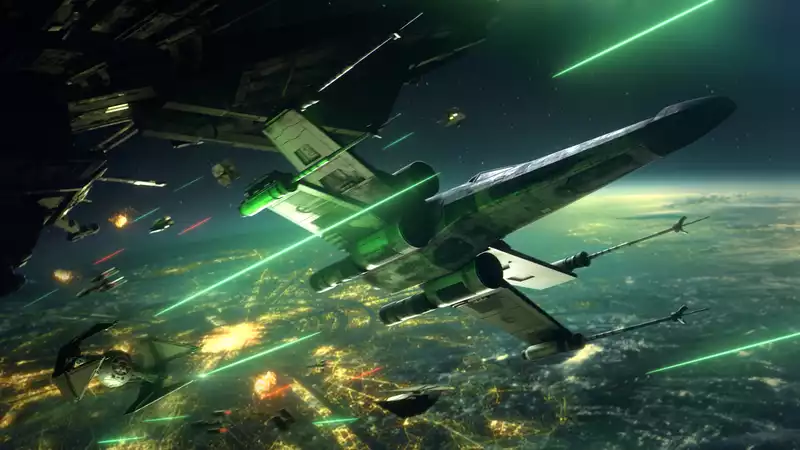"Star Wars: Squadrons" may herald the return of the Star Wars flight sim. We know from the first trailer and the dressed-up look of the gameplay that those chunky ship dashboards and fancy controls look nice, and the promise of full VR support and full HOTAS setup piques PC gamers' interest even more. But what about actual play? Polygon's interview with Ian Frazier, creative director of [Star Wars: Squadrons], finally gives us a hint. Read on to find out how power comes and goes, where the Squadrons' flight model is derived from, and what it's like to design interesting combat in established space settings.
Flight Modeling and Aiming Reticles
It may be a space flight sim, but Squadrons is not exactly simulating space flight. First and foremost," says Frazier, "it is inspired by World War II aerial combat footage. The combat feels more grounded compared to realistic space flight sims like Elite: Dangerous and Star Citizen.
Squadrons also lack leading reticles, making them more akin to World War II dogfighters. Frazier explains: "However, the color of the sighting reticle changes to signal when a properly aimed shot will hit.
But this terrestrial sense is only a starting point. 'Okay, based on something like World War II, how do we amplify that with something like power management? What would an accelerated version of that look like? Let's dig in.
How ship power systems work
Ship power systems are divided into shields, lasers, and engines. The higher the power of the laser, the faster the recharge and the faster the launch speed. Higher engine power increases speed and sharpens turning. Shield power is directional, forward and aft.
However, as an added layer, keeping each system at full power provides a bonus. Overcharging the engine builds up extra boost power, which can be used to get out of rough situations or perform wild drift maneuvers. If the boost is cut off halfway through, it can be used to make sharp turns, change direction, or shoot down pursuers. Hammered
Laser overcharges deal additional damage for a short time, and shield overcharges provide a second layer of defense for a bit; according to Frazier, these overcharge capabilities are meant to solve the "death loop" problem common in dogfighting games. They are there to solve the "death loop" problem common in dogfighting games, he says. They chase you and you chase them."
However, some ships do not have shields and instead have a special power conversion capability that allows the pilot to "quickly divert power from the engines to the lasers and vice versa," according to Frazier. But that rapid power conversion comes at a price. When all power is transferred from the engine to the laser, the ship stops for a few seconds. Similarly, if all power is transferred from the laser to the engine, the ship will not be able to fire for a short while.
This is a dangerous trade-off and may require a more agile pilot, but according to Frazier, "It really helps for ships like the TIE fighters that don't have shields.
Ship modifications, example and inspiration ship modifications, are going to play a big role in the depth of Squadrons' combat, Frazier says, and are not just shallow status buffs. Rather, it's something much bigger, even passive, that will make a real difference."
[26]He cites the example of the Channel Laser mod, a constant beam that can be seen firing from the TIE Bomber in the trailer. According to Frazier, it will be available for both factions, and it is unclear whether it will be for all ships or the bomber class, and "inspired by the beams of the Blade Wing in Star Wars Rebels.
See the miniatures game Star Wars X-Wing for other ideas expected for the mod. Don't expect a one-to-one conversion from miniatures to ship mods.
Design balanced combat around the Star Wars canon
"How to balance the New Republic and the Empire." Frazier also mentions designing within the established lore of the Star Wars universe, which only grows more complex and contentious with each passing year. When asked how much leeway the team is allowed to take in order to make the design fun and competitive, Frazier responded that they play with negative space while remaining faithful. [For example, in "Star Wars," TIE fighters don't have shields, so in "Squadron," TIE fighters don't have shields. However, according to Frazier, there is no norm for how many hit points a TIE fighter has; a TIE fighter may have as many as it needs to play ball.
Most of Squadron's creative freedom comes from where it is placed in the timeline. According to Frazier, since Squadrons takes place after Return of the Jedi, it is assumed that each faction is tinkering with new technology after the Rebels kicked the Empire's ass when they least expected it. Suddenly, the rebels are in power and pursuing their momentum, while the empire is on the back foot. The idea of each faction playing with new technology is not at all far-fetched, much like what Frazier says can be seen as ship modifications in Squadrons. The revival of Jedi-era technology is just the baseline.
I am interested to see if coloring within the Disney lines will give them the creative freedom to create a truly great spaceflight sim, but I think they need to play with all kinds of ships and mods to understand what kind of game it is. Luckily for us TIE fighter fans, it won't be long; Star Wars: Squadrons is out October 2."
.

Comments